
Sonic Flux
Sonic Flux
Sound, Art, and Metaphysics
Christoph Cox
The University of Chicago Press
Chicago and London
The University of Chicago Press, Chicago 60637
The University of Chicago Press, Ltd., London
2018 by The University of Chicago
All rights reserved. No part of this book may be used or reproduced in any manner whatsoever without written permission, except in the case of brief quotations in critical articles and reviews. For more information, contact the University of Chicago Press, 1427 E. 60th St., Chicago, IL 60637.
Published 2018
Printed in the United States of America
27 26 25 24 23 22 21 20 19 18 1 2 3 4 5
ISBN-13: 978-0-226-54303-1 (cloth)
ISBN-13: 978-0-226-54317-8 (paper)
ISBN-13: 978-0-226-54320-8 (e-book)
DOI: https://doi.org/10.7208/chicago/9780226543208.001.0001
Library of Congress Cataloging-in-Publication Data
Names: Cox, Christoph, 1965 author.
Title: Sonic flux : sound, art, and metaphysics / Christoph Cox.
Description: Chicago ; London : The University of Chicago Press, 2018. | Includes bibliographical references and index.
Identifiers: LCCN 2018015041 | ISBN 9780226543031 (cloth : alk. paper) | ISBN 9780226543178 (pbk. : alk. paper) | ISBN 9780226543208 (e-book)
Subjects: LCSH: MusicPhilosophy and aesthetics. | Soundscapes (Music)Philosophy and aesthetics. | Sound (Philosophy) | Sound installations (Art) | Metaphysics.
Classification: LCC ML3877.C77 2018 | DDC 534dc23
LC record available at https://lccn.loc.gov/2018015041
 This paper meets the requirements of ANSI/NISO Z39.481992 (Permanence of Paper).
This paper meets the requirements of ANSI/NISO Z39.481992 (Permanence of Paper).
For my parents
Christa Begemann Cox
AND
James D. Cox
Contents
Written over many years, Sonic Flux was made possible through the generosity, wisdom, camaraderie, and support of a great many people. The book took shape through a series of talks at academic and art spaces throughout the United States and Europe. I thank the audiences at those events and especially my hosts at the Museum of Contemporary Photography, Chicago (Natasha Hollins Egan); the University of California, San Diego (Ben Piekut, Jerry Balzano); Wesleyan University (Ron Kuivila); the Henry Art Gallery, Seattle (Sara Krajewski, Fionn Meade); the University of South Florida Contemporary Art Museum (Preston Poe, Robert Lawrence, Alexa Favata); Bryn Mawr College (Michael Krausz); the University of Copenhagen (Erik Granly, Sren Mller Srenson, Torben Sangild, Brandon LaBelle); Yale University (Seth Kim-Cohen); the University of Amsterdam (Tereza Havelkov); the MATA Festival (Christopher McIntyre, Missy Mazzoli); Aarhus University (Ansa Lnstrup); the Academy of Fine Arts Vienna (Diedrich Diederichsen, Constanze Ruhm); Kill Your Timid Notion Festival, Dundee (Barry Esson, Bryony McIntyre); Project Arts Centre, Dublin (Jennifer Walshe); Rensselaer Polytechnic Institute (Michael Century, Mary Anne Staniszewski); Amherst College (Jason Robinson); The Public School, New York City (Jeanne Dreskin, Alexander Provan); ISSUE Project Room (Lawrence Kumpf); New York University (Nina Katchadourian); Notam, Oslo (Notto Thelle, Jran Rudi); the School of the Art Institute of Chicago (Lou Mallozzi); the Swiss Institute, New York (Piper Marshall); Dia:Beacon (Kelly Kivland); the Whitney Museum of American Art (Margie Weinstein, Christian Marclay); City University of New York (Claire Bishop, Meredith Mowder); the Art & Law Program (Sergio Muoz Sarmiento); Goethe-Universitt, Frankfurt (Bernd Herzogenrath); Tuned City Brussels (Raviv Ganchrow, Julia Eckhardt); the Museum of Modern Art, New York (Barbara London, Leora Morinis); the Center for Experimental Lectures (Gordon Hall); the New Museum of Contemporary Art (Alicia Ritson, Johanna Burton, Lauren Cornell); the California College of the Arts (Leigh Markopoulos, Brian Conley); the Vera List Center for Art and Politics (Anne Barlow, Kristen Chappa, Lindsey Berfond); Brown University (Nathan Lee, Tony Cokes); Barnes Foundation (Katherine Skovira, Robert Whalen); the University of California, Berkeley (Jessica Ruffin, Paul Joseph Hoehn); and the Subtropics Festival, Miami (Gustavo Matamoros, Natalia Zuluaga).
Conversations and exchanges with friends, colleagues, scholars, and artists have been tremendously valuable in shaping my ideas and arguments. Special thanks to Seth Kim-Cohen for years of spirited discussion. Ed Dimendberg offered wise counsel and steadfast encouragement. Dan Smith provided expert elucidation of central Deleuzian concepts and arguments. Risha Lee at the Rubin Museum guided me through important aspects of South Asian sonic metaphysics. Cindy Keefer at the Center for Visual Music clarified aspects of Oskar Fischingers work. Hauke Harder suggested alternative readings of several pieces by Alvin Lucier. John Gunther at Hampshire College provided extraordinary media support. Many others contributed helpful ideas and encouragement, among them Keith Ansell-Pearson, Johanna Burton, Ann Butler, Seth Cluett, Nic Collins, Tony Cokes, Brian Conley, Kira de Coudres, Charles Eppley, Luke Fowler, Jennie Gottschalk, David Grubbs, Jenny Jaskey, Branden Joseph, Galen Joseph-Hunter, Doug Kahn, Brian Kane, Nina Katchadourian, Matt Krefting, Chris Kubick, Christina Kubisch, Sanford Kwinter, Brandon LaBelle, Francisco Lpez, Suhail Malik, Leigh Markopoulos, Gustavo Matamoros, Fionn Meade, Julie Beth Napolin, Paul ONeill, Jenny Perlin, Ben Piekut, Monique Roelofs, Marina Rosenfeld, Aura Satz, Carsten Seiffarth, Mary Simpson, sa Stjerna, Jeannine Tang, David Toop, Stephen Vitiello, Salom Voegelin, Jeff Wallen, Jennifer Walshe, Gregory Whitehead, and Neil Young.
Sincere thanks to Susan Bielstein and James Toftness, my editors at the University of Chicago Press, for their enthusiastic support of this project and expert guidance. I also thank the anonymous reviewers for the press whose careful reading and wise suggestions made this a better book, and Barbara Norton, who meticulously copyedited the manuscript.
I have learned much from students in my Audio Culture, Sonic Philosophy, and Sonic Turn courses at Hampshire College and the Center for Curatorial Studies, Bard College, and from my colleague Dan Warner, with whom I have taught Audio Culture for years.
For inviting me to guest-curate sound-based exhibitions, I thank Debra Singer and Matthew Lyons at The Kitchen; Toby Kamps at the Museum of Contemporary Arts Houston; Sandra Percival at New Langton Arts; Regine Basha at No Longer Empty; Annie Gawlak at G Fine Art; Bradley McCallum at the Brick + Mortar International Video Art Festival; and Julian Navarro at CONTEXT Art Miami. I also thank the many artists who generously shared their work with me, among them Olivia Block, Manon de Boer, Jens Brand, Maria Chavez, Mike Dunford, Richard Garet, Andy Graydon, Florian Hecker, Ernst Karel, Seth Kim-Cohen, Jacob Kirkegaard, Anne Walsh, Annea Lockwood, Alvin Lucier, Christian Marclay, Mattin, Jake Meginsky, Angel Nevarez and Valerie Tevere, Carsten Nicolai, Pauline Oliveros, Lee Patterson, Michael Pisaro, Mathias Poledna, liane Radigue, Lis Rhodes, Billy Roisz, Steve Roden, Julian Rosefeldt, Stefan Rummel, Robert Sember, Wadada Leo Smith, Jan-Peter E. R. Sonntag, and Jana Winderen.
I am also grateful to Hampshire College deans Norm Holland, Jeff Wallen, Sura Levine, and Eva Rueschemann for granting faculty development funding to support my research. Of the many people who facilitated my image research, I offer special thanks to Bill Dietz at the Maryanne Amacher Archive; Silvia Neuhaus at the Estate of Max Neuhaus; Ernst Karel and Kendra McLaughlin at the Sensory Ethnography Lab; Annea Lockwood and Mimi Johnson; Carl Testa and Kyoko Kitamura at the Tri-Centric Foundation; Gisela Gronemeyer at MusikTexte; Rebekah Morin at the Milwaukee Art Museum; and Jonathan Hiam at the New York Public Library.
Next page
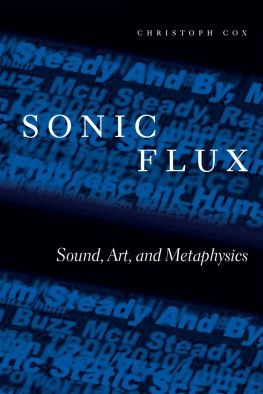

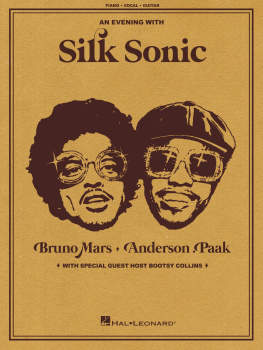
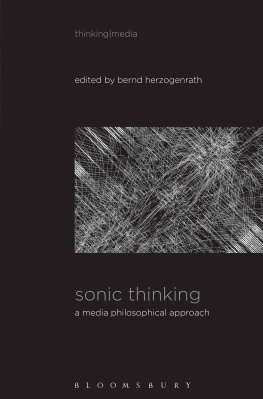


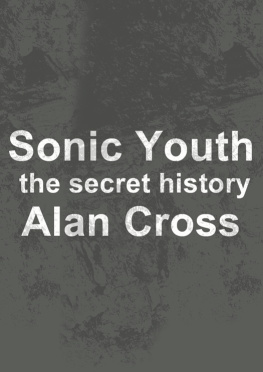
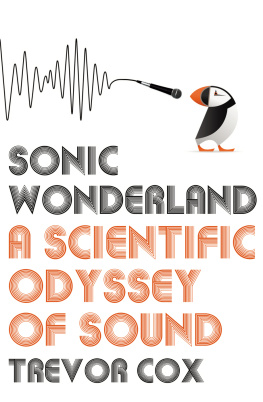
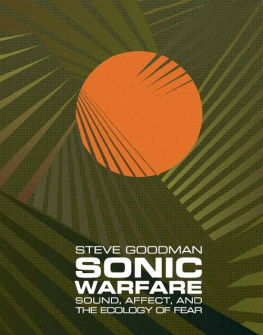

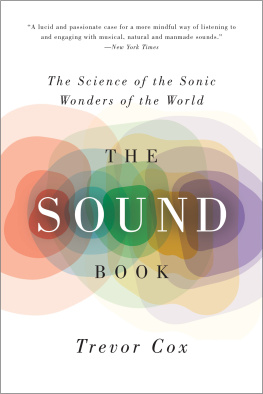
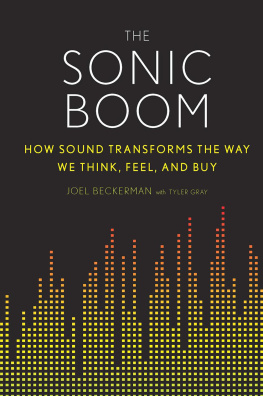

 This paper meets the requirements of ANSI/NISO Z39.481992 (Permanence of Paper).
This paper meets the requirements of ANSI/NISO Z39.481992 (Permanence of Paper).